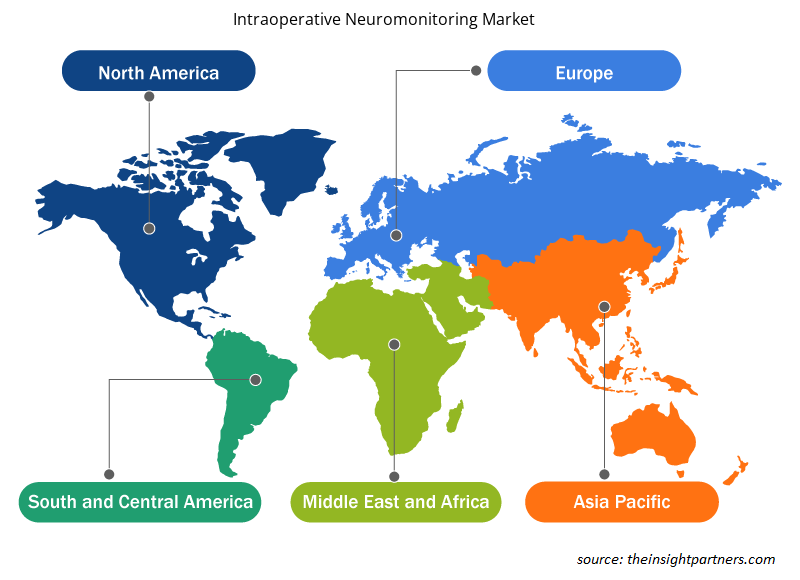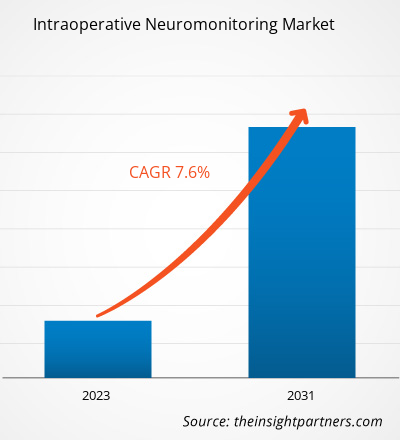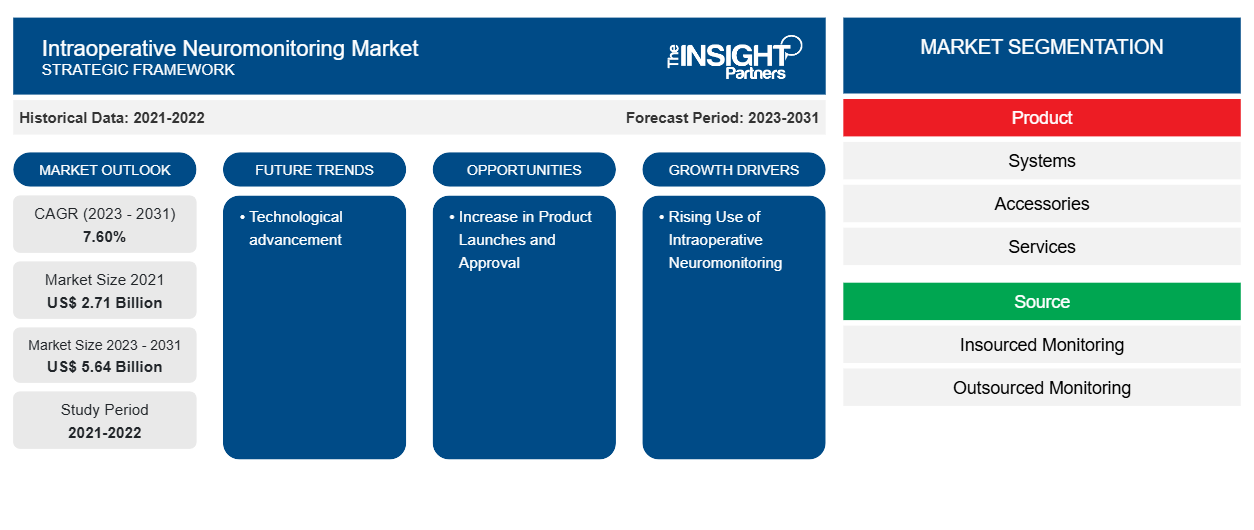Il mercato del neuromonitoraggio intraoperatorio è stato valutato a 2,71 miliardi di dollari nel 2021 e si prevede che raggiungerà i 5,64 miliardi di dollari entro il 2031. Si prevede che il mercato registrerà un CAGR del 7,60% nel 2023-2031. Il progresso tecnologico rimarrà probabilmente una delle principali tendenze del mercato del neuromonitoraggio intraoperatorio.intraoperative neuromonitoring market was valued at US$ 2.71 billion in 2021 and is expected to reach US$ 5.64 billion by 2031. The market is expected to register a CAGR of 7.60% in 2023–2031. Technological advancement will likely remain key intraoperative neuromonitoring market trends.
Analisi di mercato del neuromonitoraggio intraoperatorio
I driver del neuromonitoraggio intraoperatorio (IONM) sono gli operatori sanitari incaricati di eseguire e interpretare il neuromonitoraggio durante le procedure chirurgiche. Questi individui sono solitamente neurofisiologi o tecnici altamente qualificati che utilizzano varie tecniche di monitoraggio per valutare l'integrità funzionale del sistema nervoso in tempo reale. Lo sviluppo tecnologico continuo stava migliorando le capacità dei sistemi IONM, consentendo un monitoraggio più accurato e in tempo reale durante le procedure chirurgiche. L'uso di IONM stava crescendo come chirurghi e altri professionisti medici. Oltre a migliorare la sicurezza del paziente, IONM riduce il rischio di danni ai nervi aiutando nel monitoraggio del sistema nervoso in tempo reale durante gli interventi chirurgici. Per migliorare i risultati e ridurre i problemi postoperatori, i chirurghi utilizzano IONM per identificare e trattare potenziali complicazioni chirurgiche, come compressione o danno ai nervi. La necessità di servizi IONM per migliorare la sicurezza del paziente durante procedure complicate sta crescendo man mano che vengono eseguiti più interventi chirurgici. Un numero maggiore di interventi chirurgici porta a un maggiore utilizzo di IONM, in particolare quelli che coinvolgono strutture neurali delicate. Riassumendo, l'aumento delle procedure mediche ha un impatto sul neuromonitoraggio interoperatorio, stimolando il progresso, aumentando la forza lavoro e sottolineando l'importanza di integrare il neuromonitoraggio nelle procedure chirurgiche di routine.
Panoramica del mercato del neuromonitoraggio intraoperatorio
L'IONM, uno dei sottocampi in più rapida crescita in neurologia, utilizza la tecnologia elettrofisiologica per identificare le strutture nervose che richiedono protezione durante le procedure neurochirurgiche e per vedere cosa sta accadendo in tutto il corpo. In generale, le registrazioni dei potenziali elettrici che fluiscono attraverso il sistema nervoso durante l'intervento chirurgico vengono utilizzate per monitorare e mappare i segnali elettrici nel corpo tramite IONM guidata da neurologi. L'IONM utilizza varie tecniche, ciascuna selezionata per usi altamente particolari. Inoltre, diverse modalità possono essere utilizzate nello stesso intervento chirurgico, a seconda della procedura selezionata. Possono essere utilizzate elettroencefalografia (EEG), potenziali evocati somatosensoriali (SSEP), potenziali evocati visivi (VEP), potenziali evocati uditivi del tronco encefalico (BAEP), potenziali evocati motori (MEP), elettromiografia e altre tecniche. I pazienti sottoposti a un'ampia gamma di interventi chirurgici sul sistema nervoso centrale, come procedure radiologiche interventistiche, correzione spinale ortopedica, chirurgia dell'epilessia e neurochirurgia craniofacciale , possono trarre beneficio da queste tecniche. Sebbene possa essere applicata ad altri campi come la chirurgia vascolare ed endocrina, viene utilizzata più frequentemente nella chirurgia spinale, dell'epilessia, dei tumori cerebrali e cerebrovascolare.
Personalizza questo report in base alle tue esigenze
Riceverai la personalizzazione gratuita di qualsiasi report, comprese parti di questo report, o analisi a livello nazionale, pacchetto dati Excel, oltre a usufruire di grandi offerte e sconti per start-up e università
-
Scopri le principali tendenze di mercato in questo rapporto.Questo campione GRATUITO includerà analisi di dati che spaziano dalle tendenze di mercato alle stime e alle previsioni.
Driver e opportunità del mercato del neuromonitoraggio intraoperatorio Neuromonitoring Market Drivers and Opportunities
L'aumento dell'uso del neuromonitoraggio intraoperatorio favorisce il mercato
Ion Mapping and Microsurgery (IONM) migliora la sicurezza del paziente aiutando i chirurghi a evitare danni alle strutture cerebrali critiche e a ridurre il rischio di complicazioni durante le procedure, fornendo loro un feedback in tempo reale. Durante le procedure, in particolare quelle che comportano la vicinanza a nervi vitali, i chirurghi possono ottenere una navigazione precisa utilizzando IONM per monitorare l'integrità funzionale del sistema nervoso. IONM aiuta nella rilevazione precoce di potenziali problemi riducendo il rischio di complicazioni come danni ai nervi, paralisi o perdita sensoriale sia durante che dopo l'intervento chirurgico. La combinazione di questi fattori sottolinea l'importanza del neuromonitoraggio intraoperatorio nelle moderne impostazioni chirurgiche, promuovendone l'adozione come pratica standard in molte procedure.
Aumento dei lanci e delle approvazioni dei prodotti: un'opportunità nel mercato del neuromonitoraggio intraoperatorio
A causa della crescente domanda globale da parte di una popolazione considerevole, il settore sanitario è in continua espansione, aumentando lo sviluppo di nuovi prodotti, i lanci e le approvazioni. I principali attori del mercato investono anche in ricerca e sviluppo per promettere innovazione e creare prodotti efficaci. Ad esempio, nell'ottobre 2023, una caratteristica rivoluzionaria del sistema di neuromonitoraggio intraoperatorio (IONM) Neuromaster G1 è la soluzione One View, introdotta da Nihon Kohden, un produttore leader mondiale di apparecchiature elettroniche mediche. Questo nuovo approccio consente al software IONM di integrare perfettamente i dati neurologici con i segni vitali del paziente, come frequenza cardiaca, SpO2, temperatura e altro, mantenendo l'anestesia del paziente.Neuromaster G1 intraoperative neuromonitoring (IONM) system is the One View solution, introduced by Nihon Kohden, a leading global manufacturer of medical electronic equipment. This novel approach enables the IONM software to seamlessly integrate neurological data with the patient's vital signs, such as heart rate, SpO2, temperature, and more, while maintaining the patient's anesthesia.
Analisi della segmentazione del rapporto di mercato sul neuromonitoraggio intraoperatorio
I segmenti chiave che contribuiscono alla derivazione dell'analisi di mercato del neuromonitoraggio intraoperatorio sono prodotto, fonte, applicazione, modalità e utente finale.
- In base al prodotto, il mercato del neuromonitoraggio intraoperatorio è suddiviso in sistemi, accessori, servizi. Il segmento dei sistemi ha detenuto una quota di mercato maggiore nel 2023.
- In base alla fonte, il mercato è segmentato in monitoraggio insourcing e monitoraggio insourcing.
- In termini di applicazione, il mercato è suddiviso in chirurgia spinale, neurochirurgia, chirurgia vascolare, chirurgia otorinolaringoiatrica, chirurgia ortopedica e altri interventi chirurgici.
- In base alla modalità, il mercato è segmentato in potenziali evocati motori, potenziali evocati somatosensoriali, elettroencefalografia, elettromiografia, potenziali evocati uditivi del tronco encefalico, potenziali evocati visivi.
- In base all'utente finale, il mercato del neuromonitoraggio intraoperatorio è suddiviso in ospedali e centri chirurgici ambulatoriali.
Analisi della quota di mercato del neuromonitoraggio intraoperatorio per area geografica
L'ambito geografico del rapporto di mercato sul neuromonitoraggio intraoperatorio è suddiviso in cinque regioni: Nord America, Asia Pacifico, Europa, Medio Oriente e Africa e Sud America/Sud e Centro America.
Il Nord America ha dominato il mercato del neuromonitoraggio intraoperatorio. In Nord America, gli Stati Uniti sono il mercato più grande per il neuromonitoraggio intraoperatorio nel 2023. Inoltre, si prevede che l'Asia Pacifica crescerà con il CAGR più elevato nei prossimi anni. L'IONM stava diventando sempre più popolare nell'Asia-Pacifico a causa della crescente consapevolezza, dei progressi tecnologici e di un aumento delle procedure chirurgiche. La crescente domanda di soluzioni sanitarie all'avanguardia e la comprensione dei vantaggi del neuromonitoraggio durante le procedure chirurgiche guidano la crescita del mercato IONM dell'Asia-Pacifico. I principali ospedali e strutture sanitarie nell'area Asia-Pacifico hanno adottato l'IONM come procedura standard per interventi chirurgici complessi per migliorare la sicurezza dei pazienti. L'IONM è ampiamente utilizzato negli interventi chirurgici ortopedici e spinali nella regione Asia-Pacifico, dove c'è una significativa necessità di monitorare le strutture neurali durante queste procedure.
Approfondimenti regionali sul mercato del neuromonitoraggio intraoperatorio
Le tendenze regionali e i fattori che influenzano il mercato del neuromonitoraggio intraoperatorio durante il periodo di previsione sono stati ampiamente spiegati dagli analisti di Insight Partners. Questa sezione discute anche i segmenti e la geografia del mercato del neuromonitoraggio intraoperatorio in Nord America, Europa, Asia Pacifico, Medio Oriente e Africa e America meridionale e centrale.

- Ottieni i dati specifici regionali per il mercato del neuromonitoraggio intraoperatorio
Ambito del rapporto di mercato sul neuromonitoraggio intraoperatorio
| Attributo del report | Dettagli |
|---|---|
| Dimensioni del mercato nel 2021 | 2,71 miliardi di dollari USA |
| Dimensioni del mercato entro il 2031 | 5,64 miliardi di dollari USA |
| CAGR globale (2023-2031) | 7,60% |
| Dati storici | 2021-2022 |
| Periodo di previsione | 2023-2031 |
| Segmenti coperti |
Per Prodotto
|
| Regioni e Paesi coperti |
America del Nord
|
| Leader di mercato e profili aziendali chiave |
|
Densità degli attori del mercato: comprendere il suo impatto sulle dinamiche aziendali
Il mercato del neuromonitoraggio intraoperatorio sta crescendo rapidamente, spinto dalla crescente domanda degli utenti finali dovuta a fattori quali l'evoluzione delle preferenze dei consumatori, i progressi tecnologici e una maggiore consapevolezza dei benefici del prodotto. Con l'aumento della domanda, le aziende stanno ampliando le loro offerte, innovando per soddisfare le esigenze dei consumatori e capitalizzando sulle tendenze emergenti, il che alimenta ulteriormente la crescita del mercato.
La densità degli operatori di mercato si riferisce alla distribuzione di aziende o società che operano in un particolare mercato o settore. Indica quanti concorrenti (operatori di mercato) sono presenti in un dato spazio di mercato in relazione alle sue dimensioni o al valore di mercato totale.
Le principali aziende che operano nel mercato del neuromonitoraggio intraoperatorio sono:
- Medtronic
- Neurosoft
- Società Nihon Kohden
- Società di Neuroscienze IntraNerve, LLC
- NuVasive, Inc.
- Prodotti medici Neurovision
Disclaimer : le aziende elencate sopra non sono classificate secondo un ordine particolare.

- Ottieni una panoramica dei principali attori del mercato del neuromonitoraggio intraoperatorio
Notizie di mercato e sviluppi recenti sul neuromonitoraggio intraoperatorio
Il mercato del neuromonitoraggio intraoperatorio viene valutato raccogliendo dati qualitativi e quantitativi post-ricerca primaria e secondaria, che includono importanti pubblicazioni aziendali, dati di associazioni e database. Di seguito è riportato un elenco degli sviluppi nel mercato del neuromonitoraggio intraoperatorio e delle strategie:
- MPOWERHealth, pioniere nel campo del neuromonitoraggio intraoperatorio (IONM), ha annunciato l'acquisizione strategica delle attività di Assure Neuromonitoring nei mercati chiave, segnando un passo significativo nell'espansione dei suoi servizi di neuromonitoraggio intraoperatorio (IONM) best-in-class. L'acquisizione mirata aumenta la copertura dei pazienti di MPOWERHealth a oltre 55.000 all'anno, consolidando il suo ruolo di leader nel miglioramento della sicurezza chirurgica e dei risultati per i pazienti (Fonte: MPOWERHealth Company Name, Newsletter, 2024)
- Brainlab, un'azienda di tecnologia medica digitale, ha annunciato l'acquisizione di Dr. Langer Medical GmbH. Con sede a Waldkrich, in Germania, l'azienda a conduzione familiare è specializzata nello sviluppo di soluzioni di neuromonitoraggio intraoperatorio e relative apparecchiature per interventi chirurgici. (Fonte: Brainlab AG Company Name, Press Release, 2022)
Copertura e risultati del rapporto di mercato sul neuromonitoraggio intraoperatorio
Il rapporto "Dimensioni e previsioni del mercato del neuromonitoraggio intraoperatorio (2021-2031)" fornisce un'analisi dettagliata del mercato che copre le seguenti aree:
- Dimensioni e previsioni del mercato a livello globale, regionale e nazionale per tutti i segmenti di mercato chiave coperti dall'ambito
- Dinamiche di mercato come fattori trainanti, vincoli e opportunità chiave
- Principali tendenze future
- Analisi dettagliata delle cinque forze PEST/Porter e SWOT
- Analisi di mercato globale e regionale che copre le principali tendenze di mercato, i principali attori, le normative e gli sviluppi recenti del mercato
- Analisi del panorama industriale e della concorrenza che copre la concentrazione del mercato, l'analisi della mappa di calore, i principali attori e gli sviluppi recenti
- Profili aziendali dettagliati
- Analisi storica (2 anni), anno base, previsione (7 anni) con CAGR
- Analisi PEST e SWOT
- Valore/volume delle dimensioni del mercato - Globale, Regionale, Nazionale
- Industria e panorama competitivo
- Set di dati Excel
Report recenti
Testimonianze
Motivo dell'acquisto
- Processo decisionale informato
- Comprensione delle dinamiche di mercato
- Analisi competitiva
- Analisi dei clienti
- Previsioni di mercato
- Mitigazione del rischio
- Pianificazione strategica
- Giustificazione degli investimenti
- Identificazione dei mercati emergenti
- Miglioramento delle strategie di marketing
- Aumento dell'efficienza operativa
- Allineamento alle tendenze normative























 Ottieni un campione gratuito per - Mercato del neuromonitoraggio intraoperatorio
Ottieni un campione gratuito per - Mercato del neuromonitoraggio intraoperatorio